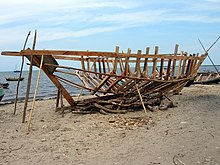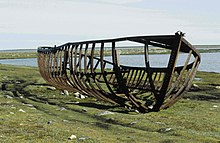Frame
The term frame (either the frame or the frame ) originally comes from shipbuilding . It refers to a load-bearing component used to reinforce the hull of boats , ships , rigid airships , aircraft and other vehicles.
Basics
The frames are also the carriers of the planking . This construction method saves a considerable amount of weight compared to a massive construction method (such as for example with a built-in structure ). The frame construction is used today not only in vehicle construction, but also in architecture , especially in large buildings, as well as in model making , e.g. B. for landscape models. The used in the construction of a ship Konstruktionsspanten are part of the line of the crack , the drawings illustrating the shape of a ship.
One differentiates between according to their orientation
- Transverse frames that lie across the hull and keel and
- Longitudinal frames that are parallel to the keel or the main axis of the vehicle.
The frames must be connected to each other so that a hull is created. This is done on the outside through the outer skin, on the inside through beams perpendicular to the frames, the so-called stringers . Cross ribs can be connected to side, chin and space stringers and the keel. In traditional boat building, the term Weger is used (e.g. Balkweger, Kimmweger). Stringer or Weger differ from longitudinal frames in that they are not directly connected to the outer skin, but lie on the inside on the (transverse) frames. See also : support bracket
Transverse frames
The transverse ribs clearly form the “ribs” of the ship, which run upwards from the keel (the “backbone”). They are attached along the inside of the ship's wall, but are often clad from the inside and are therefore not easily visible inside the ship. The shape and width of a ship's hull is determined by the transverse ribs. The transverse ribs vary a lot depending on the shape of the hull.
In steel or timber construction, the transverse frames are attached at a greater or lesser distance from one another, depending on the purpose of the ship. The bulkhead on the largest width of the ship is called the main bulkhead .
In plastic yachts no transverse frames are used, but with them the body is stiffened mostly at regular intervals. These stiffeners run like transverse ribs across the keel on the inside of the ship's wall. They look like transverse frames and fulfill the same function of stabilizing the ship's hull; Unlike transverse ribs, however, they are not separate components, but protrusions of the plastic hull.
Transverse frames are also used in model shipbuilding - including in wooden and cardboard model shipbuilding . Cross frames that are made entirely of wood are referred to here as "full frames".
Material and construction

The classic material for frames in shipbuilding and boat building is wood . It was also used for aircraft for a long time. In the area of merchant, war and fishing ships, steel dominates today . Most yachts are made of plastic today, with frame construction using steel, wood and, especially for large yachts, aluminum. Aluminum is mostly used in aircraft construction and high-speed catamarans .
Wooden frames
Grown frames are made from crooked wood ( knee wood ) so that the course of the wood fibers largely follows the shape of the frame or the outer skin. As a result, the same strength can be achieved with a smaller cross section than with frames sawn from straight pieces, so that the weight is lower. In order to be able to produce grown frames, a warehouse with various crooked timbers is necessary, from which one can choose the most suitable one for each component using a template. This means an enormous amount of storage capacity and working time. Today, these frames are only used for restorations that place great emphasis on originality. The connection between the frames and the outer skin is made with bolts, screws or rivets . These frames were also used for Viking ships, among other things .
Sawn frames are made from straight pieces. Since wood fibers are cut during sawing, sawn frames have to be larger than grown ones and the distances between the frames have to be reduced compared to grown frames in order to achieve the same strength. This results in a higher weight. The disadvantage is the large amount of waste that is created when making adjustments. This type of frame construction is also mainly used for restoration. The attachment is carried out as with grown frames.
The double frame is composed of several pieces. To connect the individual pieces together, a second frame is bolted to the first with staggered joints. Since this connection is quite weak, the frame spacing must be particularly small, so that the weight is very high. This method is mainly used for fishing trawlers that are often exposed to heavy seas. The high weight is desirable here because it dampens the movements of the ship. The fastening is again carried out with bolts, screws or rivets.

Curved frames are "soft-boiled" with hot steam (usually in a steam box) and then shaped directly at the installation site. In contrast to the other frame constructions, this usually only happens after the outer skin has been completed. You can also bend frames into a frame made of mall frames and auxiliary battens before the hull is planked. In order to enable the tight bending radii, curved frames have a flat cross-section. Common types of wood are z. B. oak wood or the even more flexible ash wood .
Laminated frames are made of several layers of thin wood and glued together over a form. This construction only became possible after the development of suitable adhesives. Advantages compared to traditional construction methods are the low weight with good strength, which is not weakened by longitudinal connections, and low waste.
Today's meaning
Modern boats with metal or plastic hulls no longer have any actual frames. In some cases, corresponding reinforcements, especially in the keel area, are embedded in the hull, these are used for general stiffening. What has remained, however, is a subdivision of the hull shape into angled , round and S-frame designs. This describes the general shape of the hull, whether it is more round or with corners. Even hulls with clear edges are nowadays coherently laminated (plastic hulls) or welded (metal hulls) and not planked.
See also
literature
- Mayer; CF, Marquardt; RS: Ship engineering and shipbuilding technology: a guide for training and further education and for everyone interested in shipbuilding . Seehafen-Verlag, Hamburg 2006, ISBN 978-3-87743-817-6 .
- Erno Wiebeck and collective of authors: Taschenlexikon Schiffbau / Schiffahrt . Bibliographical Institute, Leipzig 1982.


